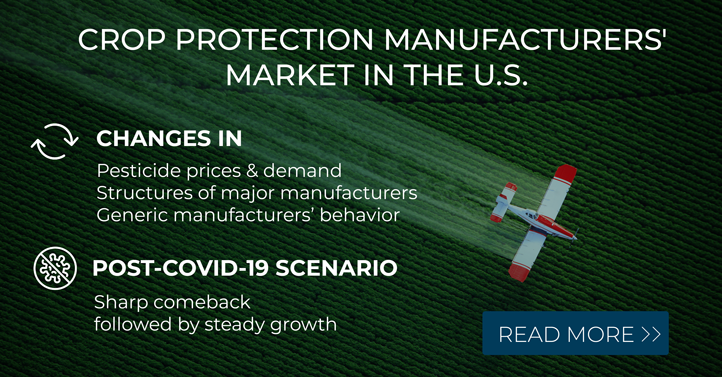In 2019, the U.S. crop protection manufacturers’ market was characterized by a decrease in sales estimated at 3.4% in comparison to 2018. All segments of the industry contributed to the decline, with a higher decrease values coming from the seed treatment, plant growth regulators, and herbicides sectors, according to Kline’s soon-to-be-published Crop Protection Manufacturers report. Various factors have led to this decline, as the industry was adapting to multiple ongoing changes, from pesticide prices and demand changes to structural changes within many leading agrochemical manufacturers.
Monsanto’s Roundup brand prices decreased slightly in 2019, while generic prices showed a small increase. However, glyphosate volumes in the United States went down by over 10%, with several generic companies discontinuing the active ingredient due to concerns over future liability risk from pending glyphosate lawsuits. Apart from declining planted crop acreage and climate change volatility, the lower prices for major row crops such as soybeans and corn have made growers cautious about the cost of inputs. This negatively affected the demand for crop protection applications and forced growers to cut expenses, which included reducing spending on crop protection chemicals.
In recent years, the industry consolidated as manufacturers looked for ways to grow their businesses through mergers and acquisitions. Dow and DuPont completed its merger and created Corteva Agriscience, and the Bayer Monsanto acquisition has been finalized. It is anticipated that consolidation within crop protection manufacturers will begin to slow. The crop protection manufacturers’ industry is dominated by leading market players such as Bayer, BASF, Syngenta, and Corteva, accounting for a significant market share. But, in 2019, generic manufacturers continued to aggressively price products that made them more attractive to growers, which contributed to their increase in market share. However, generic manufacturers are also investing more in international markets to grow their businesses, since U.S. markets experienced negative growth.
The outlook for the U.S. crop protection industry remains challenging, with more structural changes likely ahead. The agriculture sector has had an increased awareness regarding harmful chemical pesticides, resulting in the development of sustainable biological-based products through plant, mineral, and bacterial sources. Crop protection manufacturers increased their interest in the development of biopesticides, as consumer demand for organically produced food grew.
The biopesticide crop protection market is a strong driver of the industry and likely to positively impact the market through 2024, as it validates its effectiveness among traditional crop protection chemicals and continues to grow in estimated double digits. A clear example of the importance of the biological segment is the fact that major research-based manufacturers are aggressively pursuing opportunities in developing countries for areas of organic growth, and a few products developed around a biological-based formulation are likely to enter the market in coming years.
The current COVID-19 pandemic, coupled with movement restrictions, has created disruption in the manufacturing of agrochemicals due to raw material availability and is also causing complications in the supply of essential agricultural inputs. This is expected to have a plunging effect on food productivity and crop yields over the medium term.
Although prices of agricultural commodities have been hit by COVID-19, the impact is considerably lower than in other commodities. Once COVID-19 subsides, the post-pandemic scenario for the crop protection market is likely to be a relatively sharp comeback, followed by positive growth in the long term. The trend toward sustainable agriculture and healthy foods is expected to continue, and technological advances will encourage further market growth. As AgTech investments are on the rise, areas to watch include the rise of unmanned aerial vehicles, variable-rate seeding services, field mapping, yield monitor analysis, and satellite imagery.

